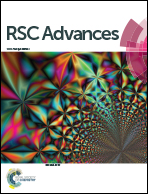Effect of HBr formation on mercury oxidation via CaBr2 addition to coal during combustion†
Abstract
Adding CaBr2 to coal to enhance elemental mercury (Hg0) oxidation during combustion has been an effective mercury control technology, but the added CaBr2 may increase levels of noxious Br2 or HBr gases in flue gas. Temperature-programmed decomposition (TPD) experiments were conducted to verify the effect of CaBr2 addition on Hg0 oxidation. The results indicated that the amount of Hg0 released initially decreased with increasing amounts of CaBr2 additive and then held steady. The optimal amount of additive was 200 μg g−1. CaBr2 addition effectively oxidized Hg0 released at relatively low temperatures only. The generation of HBr was confirmed by mass spectrometry. The formation of HBr occurred over a temperature range of 250 °C to 400 °C, and the HBr concentration first increased and then remained stable as levels of CaBr2 additive were increased in coal. The maximum concentration of HBr was 18 ppm and corresponded to 200 μg g−1 CaBr2. Further analysis indicated a strong, negative linear correlation between the amount of Hg0 released and the HBr concentration in flue gas. Based on these findings and previous studies, the possible mechanism of oxidation of Hg0 by CaBr2 was analyzed.


 Please wait while we load your content...
Please wait while we load your content...